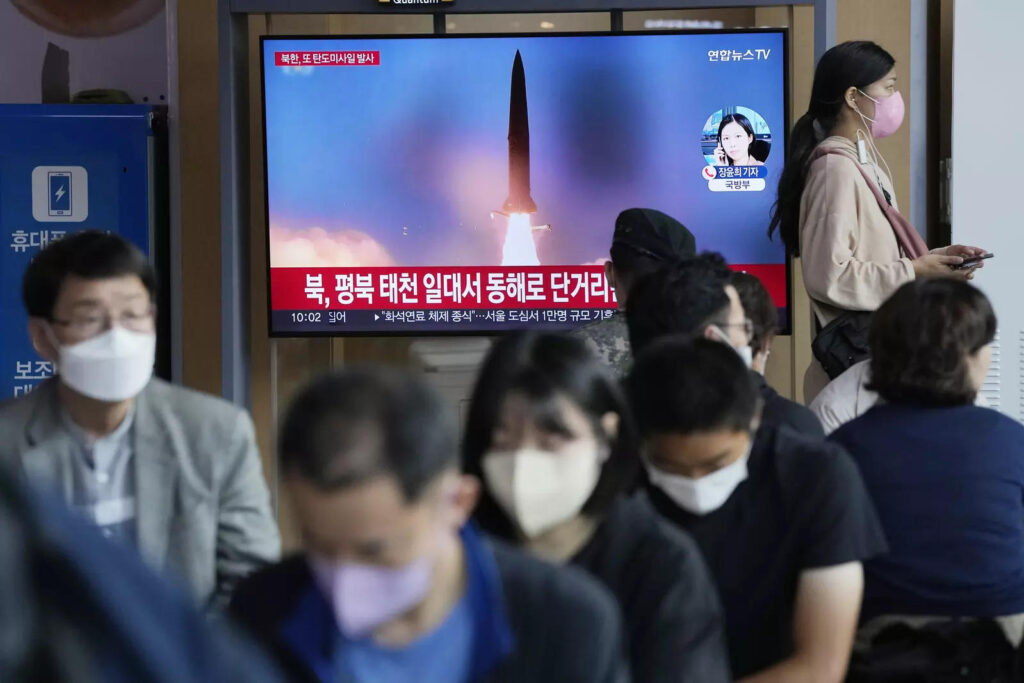In a crucial trip to Washington, US Vice President Kamala Harris visited the Demilitarized Zone separating the two Koreas only hours after Kim Jong Un’s government launched two short-range ballistic missiles into the ocean.
On Thursday, Kamala Harris became the highest-ranking member of the Biden administration to enter the 4-kilometer (2.5-mile) wide buffer where hundreds of thousands of troops are stationed on their respective sides of razor-wire fencing in a region known as the “last frontier” of the Cold War.
She was also observed by North Korean soldiers while she stood on the South Korean side of the demarcation line boundary. Harris spoke with President Yoon Suk Yeol in Seoul prior to travelling to the DMZ, where they condemned North Korea’s missile launches and agreed to take severe measures if Pyongyang followed forward with its first nuclear test in five years.
Also Read: Reliance Jio to launch 5g phone costing less than 12,000 INR: reports
Harris said at the DMZ that North Korea’s launches were “obviously a provocation” and that “the commitment of the United States to the protection of the Republic of Korea, I will report, is unbreakable.”
The DMZ, she continued, “dramatically illustrates the paths the two Koreas took after their 1950–1953 war, with South Korea becoming a thriving democracy and North Korea becoming a “brutal dictatorship,” with widespread human rights abuses and a questionable weapons program that jeopardizes international peace.”
Prior to the 2024 presidential election, Harris had the opportunity to demonstrate her ability to manage delicate ties abroad during the DMZ tour. Meeting service members and receiving an operational briefing were also included in the visit. Her visit brought attention to North Korea’s return to provocations and showed support for friends in the area, notably South Korea and Japan, who are home to the majority of US soldiers stationed there.

In defiance of United Nations Security Council resolutions, Kim has fired a record number of ballistic missiles this year while ignoring US efforts to resume stalled nuclear disarmament negotiations. This includes the first such barrage since June, the firing of two short-range ballistic missiles on Wednesday and one short-range missile on Sunday.
North Korea frequently times its provocations to coincide with political occasions. The most recent launch occurred a month after Ulchi Freedom Shield, the US and South Korea’s largest joint military exercise in about five years, and as the USS Ronald Reagan arrived in South Korea for joint exercises. The combined military drills have caused North Korea to bristle for decades, accusing them of being a precursor to an invasion.
The Biden administration must contend with North Korea as well as a stronger China, which Biden’s aides fear is acting provocatively in the Taiwan Strait.
Also Read: Pope Francis remarks, “Save the plant and find peace”
After it became evident that Harris would visit the area to attend the state burial of former Japanese Prime Minister Shinzo Abe, the vice president’s staff covertly organized the DMZ visit during the past two weeks, according to a senior administration official. But by announcing her DMZ stop at the start of their bilateral talks in Tokyo, South Korean Prime Minister Han Duck-soo overshadowed her office.
Han remarked to Harris on Tuesday, “Your tour to the DMZ and Seoul will be highly symbolic demonstrations of your strong commitment to the security and peace on the Korean Peninsula.”
The significance of Harris’ already hectic journey to the area increased when a White House representative swiftly confirmed the DMZ stop.
Nancy Pelosi, the speaker of the House, visited the Panmunjom peace hamlet in the Demilitarized Zone in August. The location where the two sides’ soldiers are facing off is a symbol of the simmering military tensions that have existed since the US defended South Korea in 1950 when North Korea invaded and ignited the Korean War.
Also Read: Nirmala Sitharaman says, “Rupee held back distinctively against US Dollar”
According to a senior administration official, Harris has met with the prime ministers of Japan and Australia on her trip, and they both discussed Taiwan. She also served as the leader of the US delegation at Abe’s state funeral, spoke with CEOs of the semiconductor sector about the recently passed CHIPS and Science Act, which is meant to increase US competitiveness with China, and paid a visit to US service members stationed in Japan on the warship USS Howard.

